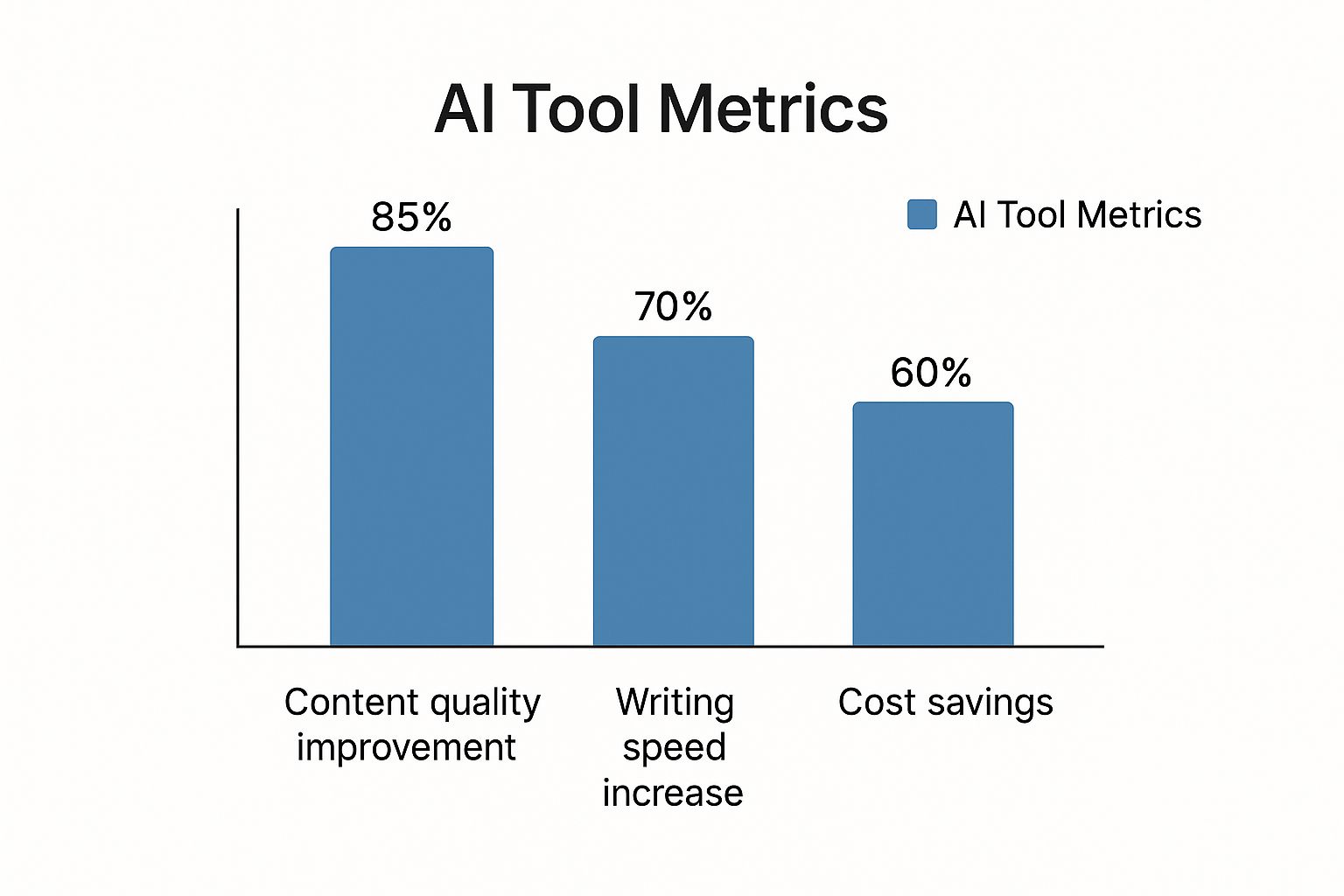
Choosing the Best AI Content Writing Tools
Published on 2025-09-25
At their core, AI content writing tools are platforms that use artificial intelligence to help you write. From blog posts and social media updates to ad copy and emails, they’re designed to help marketers get quality content out the door, faster. The best ones manage to find that sweet spot between speed and genuine quality, with features that help you go from a blank page to a finished draft.
Why AI Content Writing Tools Are Essential for Marketers

AI writers have quickly gone from a niche curiosity to a must-have in any serious marketer's toolkit. Why the sudden shift? It really comes down to the constant pressure to produce great content at a pace that’s nearly impossible for humans to keep up with. To get real results, you need a ton of content, which is why so many teams are looking for strategies to scale content marketing successfully.
The numbers don't lie. It’s expected that by 2025, over 90% of content marketers will be using AI tools in their daily workflow. That's a huge leap from 64.7% in 2023. This boom is all about efficiency, especially when you're just getting started on a piece. For example, about 71% of content marketers now turn to AI just to brainstorm ideas and beat that classic writer's block.
Overcoming Core Content Challenges
But these tools are good for more than just churning out words. They solve some of the most persistent headaches that content teams deal with every single day. AI is becoming the go-to solution for sticking to a consistent publishing schedule, exploring new topics, and even tailoring content for different audiences without completely draining your creative energy.
Here’s why so many marketers are jumping on board:
- Faster Content Creation: You can get a first draft for a blog post, a handful of social media updates, or ad copy ready in minutes instead of hours. This gives you more time to focus on strategy, fine-tuning the edits, and actually promoting the content.
- Better Brainstorming: Stuck for ideas? AI can help you come up with blog titles, create detailed outlines, and find new ways to talk about old topics.
- Consistent Publishing: Keeping a steady flow of content is key for keeping your audience engaged and for SEO. AI helps you maintain that rhythm across all your channels.
The smartest content teams aren't trying to replace humans with AI. They're pairing human creativity with AI's raw power. It's a partnership: AI does the grunt work of drafting and research, while the writer adds the strategy, nuance, and authentic voice that actually connects with people.
Let's be honest—getting good with AI content tools isn't really optional anymore if you want to stay in the game. They give you the backup you need to meet the insane demand for content, letting you and your team focus on the high-level work that actually moves the needle. This guide will walk you through the options so you can pick the right tool for your goals.
How to Evaluate AI Writing Platforms
Picking the right AI content tool is about more than just a flashy feature list. If you want a platform that actually makes your job easier, you need a solid way to evaluate it. This means cutting through the marketing noise and focusing on what truly impacts your content's quality, your efficiency, and its performance.
The first and most obvious place to start is the quality of the writing itself. Does the output sound natural and engaging? Or is it stiff, robotic, and filled with the same repetitive phrases? The best tools generate text that needs very little editing, which is where you get the real time-savings.
Just as crucial is contextual relevance. A tool can spit out grammatically perfect sentences all day, but if it completely misses the point of your prompt or fails to grasp important nuances, the content is worthless. You have to test it with a few different prompts to see how well the AI handles complex ideas and stays on track.
Assessing Core Functionality and Usability
Beyond the words on the page, the user experience is a massive factor. A clunky, confusing interface can easily wipe out any time the AI saves you. Look for platforms with an intuitive design that lets you generate, edit, and organize your work without needing a week-long training course.
Another game-changer is the ability to maintain a consistent brand voice. Some of the more advanced ai content writing tools let you create custom voice profiles or even upload style guides. This is a must-have for any business that needs every piece of content—from a blog post to a quick social media update—to sound like it came from the same team.
Here are the essential criteria I always look at:
- Output Quality and Coherence: How readable and accurate is the content? Could you publish it with just a few minor tweaks?
- Brand Voice Consistency: Can the tool actually learn and maintain your specific tone and style across everything it generates?
- Ease of Use: Is the platform straightforward? A simple, clean interface means you can work faster and without frustration.
- Integration Capabilities: Does the tool play nice with your current workflow? Think about connections to your WordPress site or social media scheduler.
The true test of an AI writing platform isn't just what it creates, but how seamlessly it fits into your existing content process. The goal is to find an assistant that enhances your work, not one that forces you to change how you do everything.
Evaluating SEO and Performance Features
For most of us, content creation and SEO are two sides of the same coin. A top-tier AI writer needs to have solid SEO features baked right in. This means it should be able to weave in target keywords naturally, suggest relevant long-tail variations, and even analyze your draft against the top-ranking competition.
Look for tools that go beyond basic keyword stuffing. The best platforms give you a real-time SEO score and practical tips to improve your content's chances of ranking. This shifts the tool from being a simple writer to a strategic partner in your content optimization.
Ultimately, you measure a tool's effectiveness by the results it produces. That’s why tracking the right metrics is so important. For a much deeper look into this, check out our guide on content performance analysis. It’ll help you connect your AI-powered content efforts to real business outcomes. When you combine powerful creation tools with sharp analysis, you start building a content machine that actually works.
A Detailed Comparison of Leading AI Content Tools
Trying to pick from the sea of AI content writing tools can be a real headache. Every platform says it's the best, but the truth is, the "best" tool really boils down to what you need it for. Are you writing long-form SEO articles or snappy social media posts? Let's cut through the marketing fluff and get into the real-world differences between three heavyweights: Jasper, Copy.ai, and Writesonic.
This graphic shows what users actually get out of bringing AI into their day-to-day work.

It’s clear that while working faster and saving money are huge wins, the biggest benefit people report is simply better content. This really drives home that AI isn't just a shortcut; it's a strategic partner.
H3: Jasper: The Enterprise-Grade Content Powerhouse
Jasper (which you might remember as Jarvis) has been a big name for a while, branding itself as the go-to for serious marketing teams and big companies. Its secret sauce is the "Brand Voice" feature. You can feed it style guides, product catalogs, and your best-performing content, and it learns to write just like you.
For bigger organizations, this is a lifesaver. It solves the massive challenge of keeping everyone on-brand, whether you have two writers or twenty. The whole platform is slick and packed with templates for just about anything you can think of, from blog posts to YouTube video scripts.
However, all that power comes with a premium price tag. Jasper is definitely one of the more expensive options out there, which can put it out of reach for freelancers or small businesses. If you're a one-person show, many of its team-focused features might feel like overkill.
H3: Copy.ai: The Versatile Tool for Sales and Marketing Copy
Copy.ai has carved out its own space by being exceptionally good at short, punchy, action-oriented writing. This is the tool for sales reps, email marketers, and social media managers who need to churn out compelling ad copy, email subject lines, and calls-to-action on the fly.
One of its slickest features is the "Infobase." You just drop in all your key company and product details once, and the AI references that info for future prompts. This is a huge time-saver when you’re creating dozens of product descriptions or sales emails, as you don't have to repeat yourself constantly.
Copy.ai feels a lot simpler and more direct than Jasper, making it super easy for newcomers to pick up. While it can handle longer articles, its real strength is in generating persuasive text that gets people to click. It even has workflow tools to help automate entire sequences, like creating a full email follow-up campaign from one simple idea.
H3: Writesonic: The All-Rounder for SEO and Factual Content
Writesonic aims to be the jack-of-all-trades, mixing powerful features with a price point that doesn't make you wince. It even comes with Photosonic, an AI image generator, and Audiosonic for text-to-speech, turning it into a full-blown content suite.
If you’re all about SEO, you’ll love Writesonic’s "AI Article Writer." It hooks up with Surfer SEO and can scan the top-ranking Google results to write factually accurate, highly-optimized articles. That ability to pull in real-time data gives it a serious advantage for creating content that's not just well-written but also timely and competitive. For a deeper dive into how different tools stack up, this list of the 12 best AI content creation tools for SEO is a great resource.
Writesonic is also much kinder to your wallet than Jasper, with a more generous free trial and affordable plans. This makes it a fantastic choice for freelancers, bloggers, and small to mid-sized businesses. The quality is solid, though you might need to do a little more tweaking to nail your brand voice perfectly. You can also see how it compares to other options in our own guide to top AI content creation tools.
H3: Making The Right Choice: A Side-By-Side View
To make this even simpler, let's put these tools head-to-head in a table. This way, you can see exactly where each one shines.
Comparing Key Features of Top AI Writing Tools
Here's a quick comparison of the leading AI content platforms, breaking down their core features, pricing, and who they’re built for.
| Tool | Key Feature | Ideal Use Case | Pricing Starts At | LinkedIn Integration |
|---|---|---|---|---|
| Jasper | Advanced Brand Voice training | Enterprise content and team collaboration | $39/mo (Creator) | Strong for brand articles and company page updates |
| Copy.ai | "Infobase" for consistent company data | Sales copy, email, and social media | $36/mo (Pro) | Excellent for outreach messages and short posts |
| Writesonic | Real-time data integration for SEO | SEO articles and factual blog posts | $13/mo (Small Team) | Good for long-form articles shared as posts |
Choosing the right tool is all about matching its strengths to your goals.
Go with Jasper if... your absolute priority is maintaining a perfect brand voice across a large team and you have the budget for a top-tier platform.
Go with Copy.ai if... you live and breathe short-form copy for sales, ads, and social media, and you love tools that automate your workflow.
Go with Writesonic if... your main goal is cranking out well-researched, SEO-friendly blog posts and you want an affordable, all-in-one tool.
Each of these platforms is a powerhouse in its own right, but they're built for different jobs. By lining up your needs with the tool designed for them, you're not just getting an AI writer—you're getting the right AI writer.
Using AI Tools to Elevate Your LinkedIn Presence

Let's be honest: LinkedIn is a different beast. It's not the place for generic blog posts or snappy ad copy. The platform demands a unique mix of authority, genuine personality, and engagement—a blend that most out-of-the-box AI content writing tools really struggle with.
But with the right approach, AI can be a game-changer for your personal brand or company page. The secret isn't just about posting more often. It's about consistently sharing valuable insights that actually connect with a professional audience. Think of AI as your brainstorming partner, not a robot that you let publish on your behalf.
Crafting a Professional Tone with AI
The first hurdle is getting the AI to sound like you, or at least someone in your industry. A lazy prompt like "write a post about leadership" will get you exactly what you deserve: a bland, forgettable post. You have to be more specific.
Give the AI context. Tell it about your role, your company, and who you're trying to talk to.
For example, instead of that generic leadership prompt, try this: "Draft a 3-paragraph LinkedIn post from the perspective of a SaaS founder. The tone should be authoritative but approachable. Talk about the common challenge of user retention, hint at a new framework for improving it, and end with a question to get people talking."
See the difference? That level of detail helps the AI slip into the right persona and create content that feels like it belongs in a specific professional conversation.
The real skill in using AI for LinkedIn is in the prompting. Your ability to provide clear, contextual instructions directly determines the quality of the output. Think of yourself as a director guiding an actor—the more precise your direction, the better the performance.
It's no surprise that the market for AI writing assistants is growing. They're cost-effective and getting smarter every day. For startups and small businesses on a tight budget, the affordability and multilingual support are a huge plus for reaching a global audience. You can discover the latest insights on the AI writing assistant market to see just how fast this space is moving.
Structuring Content for Maximum Impact
The LinkedIn algorithm loves content that keeps people on the platform. That means your posts have to be easy to read and designed to start a conversation. This is an area where AI tools can be incredibly helpful in structuring your ideas.
Here are a few practical ways to use AI for better post structure:
- Nail the Opener: Ask the AI to generate five different opening lines for your post. A strong hook is everything on a crowded feed, and having options lets you pick the one that packs the most punch.
- Use Bullet Points: If you're explaining a process or sharing tips, prompt the AI to format the key takeaways as bullet points or a numbered list. It makes your content instantly more scannable.
- Spark a Conversation: End your posts with a question. You can ask the AI to "generate three thought-provoking questions related to [your topic]" to get the comments section buzzing.
A well-structured post simply gets more eyeballs and shares. To go deeper on this, check out our complete guide to building a powerful LinkedIn content strategy.
The autoghostwriter Advantage: Specialization
While you can definitely bend general-purpose AI content writing tools to your will for LinkedIn, there's a huge advantage in using a specialized platform. A tool like autoghostwriter was built from the ground up for one thing: creating authentic, engaging LinkedIn content.
Instead of wrestling with generic templates, autoghostwriter provides workflows specifically designed for thought leadership. It helps you find and maintain a consistent voice, gives you content ideas relevant to professional networking, and generates posts that are already optimized for the LinkedIn algorithm.
This specialization cuts out a lot of the trial-and-error you face with a general AI. For anyone serious about growing their influence on LinkedIn, a purpose-built tool is almost always the fastest path to getting real results.
Choosing the Right AI Tool for Your Business

Picking the right AI content writer isn't about chasing the "best" one on the market. It’s about finding the tool that clicks with your specific business needs, content strategy, and daily workflow. What works for a solo founder is going to be worlds apart from what a big marketing agency needs.
Getting this choice right is a big deal. The wrong platform can quickly become a money pit and a source of constant frustration. The trick is to look past the shiny feature lists and really think about who is using it and what they need to accomplish. Knowing your own requirements is half the battle.
This space is blowing up for a reason—everyone wants to create content faster. The global AI writing tools market was already valued at around $0.39 billion in 2023 and is on track to hit $1.22 billion by 2031. That's a ton of growth, all fueled by the demand for speed and scale. You can dig deeper into the AI writing market's impressive growth to see what’s behind the numbers.
For the Solo Entrepreneur or Freelancer
When you're running the show yourself, time is your most precious resource. You need a tool that's all about speed and efficiency—something that can pump out solid first drafts, spitball ideas, and switch between different content types without a complicated setup or a scary price tag.
Look for platforms that offer:
- Affordable Pricing: You need powerful features that don't drain your bank account.
- Versatile Templates: A good library of templates for blogs, social media, and emails means you’re never staring at a blank page.
- Ease of Use: An intuitive interface is key. You should be able to get going in minutes, not days.
For this kind of user, a tool like Writesonic often hits that perfect balance between features and cost.
Your main decision here is all about return on your time. The best tool is the one that helps you create the most effective content in the least amount of time, freeing you up for everything else on your plate.
For the Marketing Agency
Agencies are a different beast entirely. You're juggling multiple clients, each with their own voice, goals, and quirks. This means collaboration, brand consistency, and streamlined workflows are non-negotiable. The right ai content writing tools for an agency have to be built for teamwork and quality control.
Key features for agencies include:
- Team Collaboration: You absolutely need the ability to add users, assign projects, and leave feedback right inside the platform.
- Brand Voice Customization: Tools that can actually learn and mimic a client's specific tone are a game-changer for consistency.
- Project Organization: You need to be able to wall off each client into their own workspace or folder to keep things from getting chaotic.
This is where platforms like Jasper tend to shine. They're built for teams and have some of the best brand voice features out there, even if they come with a higher price tag.
For the Enterprise Corporation
For a large corporation, the name of the game is brand governance, security, and scalability. With content coming from multiple departments, keeping a single, unified brand voice is a massive challenge. An enterprise-level AI tool has to offer rock-solid controls to make sure everything published is on-brand.
The most important things to look for are:
- Scalable Brand Controls: The ability to create and enforce detailed style guides and voice profiles across the entire organization.
- Robust Security: Enterprise-grade security is a must to protect sensitive company data.
- Seamless Integrations: The tool has to play nice with your existing tech stack, whether it’s a CMS or a digital asset management system.
Ultimately, picking an AI writer is a strategic business decision. By figuring out who you are and what features actually matter to your workflow, you can find a platform that doesn’t just make content creation faster—it delivers a real, measurable return on your investment.
Common Questions About AI Content Writing Tools
It's natural to have questions as you start weaving AI into your content workflow. Honestly, there's a lot of noise out there. Let's cut through it and tackle some of the most common concerns I hear from people every day.
The big one is always about search engines. People worry that using AI is an automatic penalty from Google. The short answer? No, it's not. Google has been crystal clear on this: they care about quality, not the method of creation.
Their algorithms are built to reward helpful, reliable, people-first content. If you're just pumping out generic, low-effort articles with an AI tool, you're going to have a bad time. But if you're using AI as a creative partner to produce something insightful and genuinely original, you're playing by the rules.
Will AI-Generated Content Hurt My SEO Rankings?
This fear of an "AI penalty" usually comes from a misunderstanding of how SEO actually works. The real danger isn't using AI; it's publishing raw, unedited AI output. Your human touch is what gives you the edge.
Treat the AI's output as a first draft. Always. From there, it's your job to:
- Fact-check everything. AI models are notorious for making stuff up with complete confidence. This is often called "hallucination."
- Inject your own experience. Add a personal story, a unique example, or some data from your own work. This is stuff only you can provide.
- Refine the tone. Make sure the final piece sounds like you or your brand, not a robot.
The smartest content creators I know treat AI-generated text as a starting point, never the final product. Your expertise and oversight are what turn a generic draft into content that actually ranks and resonates.
This "human-in-the-loop" process is what ensures your content is unique and truly helps your audience—which is exactly what search engines want to see.
How Can I Verify the Accuracy of AI Content?
Trust is everything. You can't afford to publish inaccurate information, and since AI tools can sometimes state falsehoods as facts, you need a solid verification process. It's non-negotiable.
My rule is simple: treat every statistic, date, or specific claim from an AI as unverified until proven otherwise. The next step is to check that info against multiple, reputable sources. For stats and data, I always look for the original research report, a university study, or an official publication.
For instance, if your AI tells you "73% of marketers saw a positive ROI from a certain strategy," don't just run with it. A quick search should point you to the original source. This simple habit protects your credibility and makes your content far more trustworthy.
What Is the Best AI Writing Tool for Beginners?
If you're just dipping your toes into ai content writing tools, the number of options can feel paralyzing. For beginners, the best tool is almost always the one that focuses on simplicity and a smooth user experience, not the one with a million confusing features.
You want a tool with a clean layout, straightforward instructions, and maybe a few helpful templates to get you started. A platform with a gentle learning curve lets you see results quickly without getting stuck in a menu of complex settings. Take advantage of free trials—they're perfect for test-driving a few options.
While a powerhouse tool like Jasper is incredibly capable, it can be a bit much for a newcomer. A more focused, intuitive tool is often a much better place to start. It helps you build confidence while you get the hang of writing good prompts and refining the output.
Ready to create authentic, scroll-stopping content for LinkedIn without the steep learning curve? autoghostwriter is designed specifically for professionals who want to build their personal brand with high-quality, engaging posts. Start creating with autoghostwriter today and see the difference a specialized tool can make.